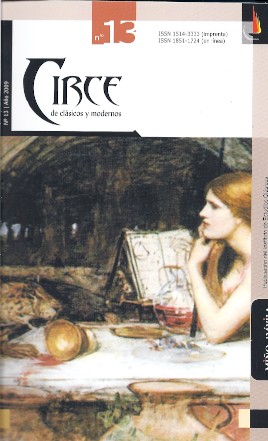The enunciation of the space in Trachiniae. Construction and annihilation of the domestic sphere
Keywords:
inner space, Trachiniae, Sophocles, door, movementAbstract
One typical aspect of the Greek theatre is the tension created in the relationship between not only different spaces but also between places that are visible and those which are not. In this occasion we will focus our attention on the bond, in the Greek tragedy, between the external and the inner spaces in the palace and their point of connection: the σκηνή door. We start from the conviction that this threshold is a key point of analysis, since it connects these spaces which correspond to especially significant appreciations in the Greek imaginary and that, besides, they integrate themselves in a revealing way in the tragic universe. Traquinias presents itself as a privileged play to tackle this issue, since in this play the different spaces and the contact among themselves are fundamental aspects for the development of the plots. In the general framework of the Semiotics of the Theatre, we will approach from the Linguistics of Enuntiation the elements of the δείξιςthat, through the reference to the movement of the actors’ bodies, they organize the discursive space and they make it possible the presence, in the scene, of the hidden dimension of the inner space.
Downloads
Downloads
Published
Issue
Section
License
Los autores que tengan publicaciones con esta revista, aceptan los términos siguientes referidos a los derechos de autor/a:
1. Los autores/as conservarán sus derechos de autor y garantizarán a la revista el derecho de primera publicación de su obra, el cuál estará simultáneamente sujeto a la Licencia de reconocimiento de Licencia Creative Commons Atribución-NoComercial-CompartirIgual 4.0 Internacional (http://creativecommons.org/licenses/by-nc-sa/4.0/). que permite a terceros compartir la obra siempre que se indique su autor y su primera publicación esta revista. El autor es el titular del copyright.
2. Los autores/as podrán adoptar otros acuerdos de licencia no exclusiva de distribución de la versión de la obra publicada (postprint) siempre que se indique la publicación inicial en esta revista. La cesión de derechos no exclusivos implica también la autorización por parte de los autores para que el trabajo sea depositado en el repositorio institucional y difundido a través de las bases de datos que el editor considere adecuadas para su indización, con miras a incrementar la visibilidad de la publicación y de sus autores.
3. Se permite y recomienda a los autores/as difundir su obra a través de Internet antes y durante el proceso de envío, lo cual puede producir intercambios interesantes y aumentar las citas de la obra publicada.







.jpg)









2.png)



